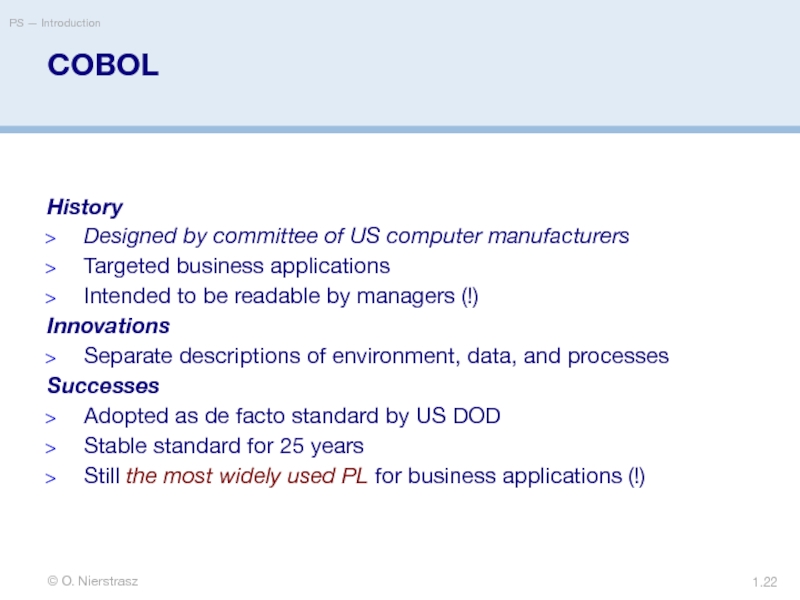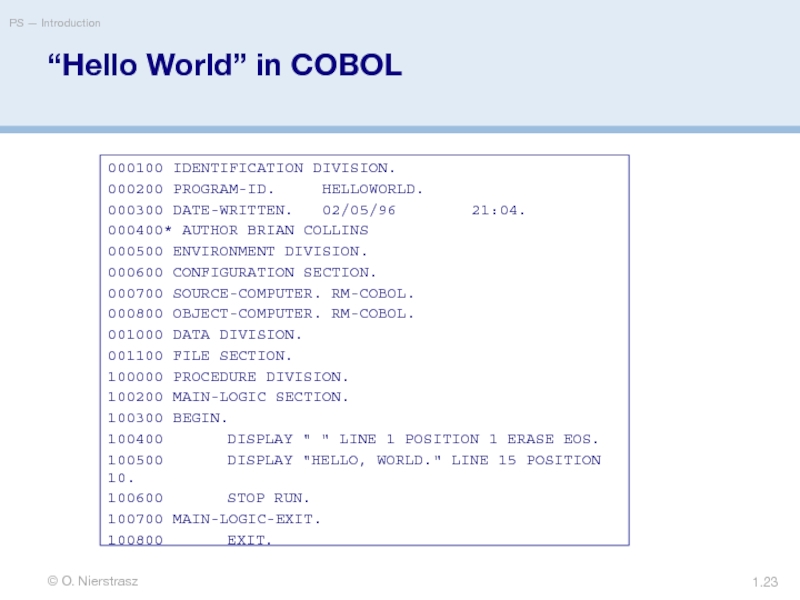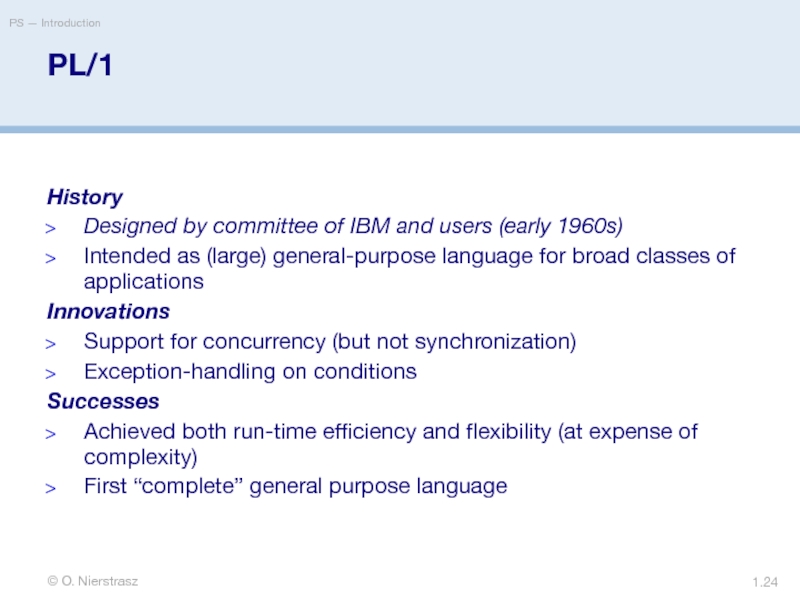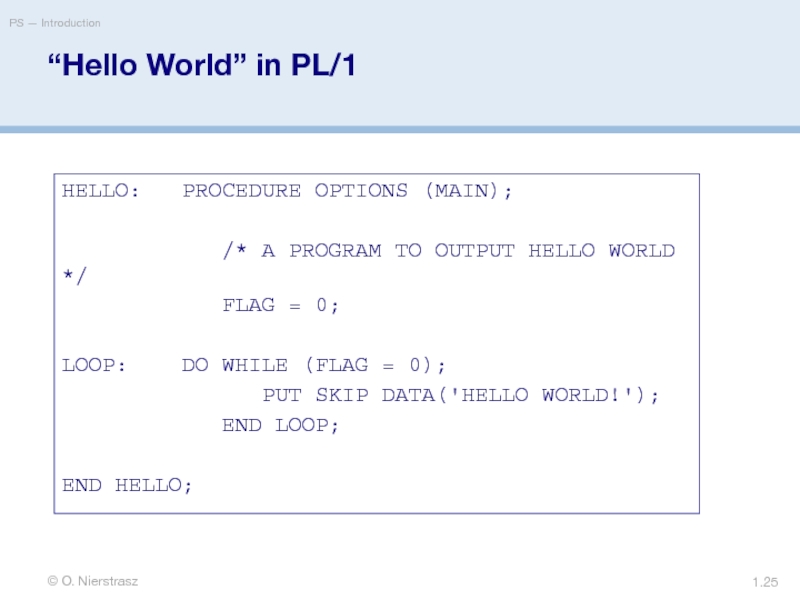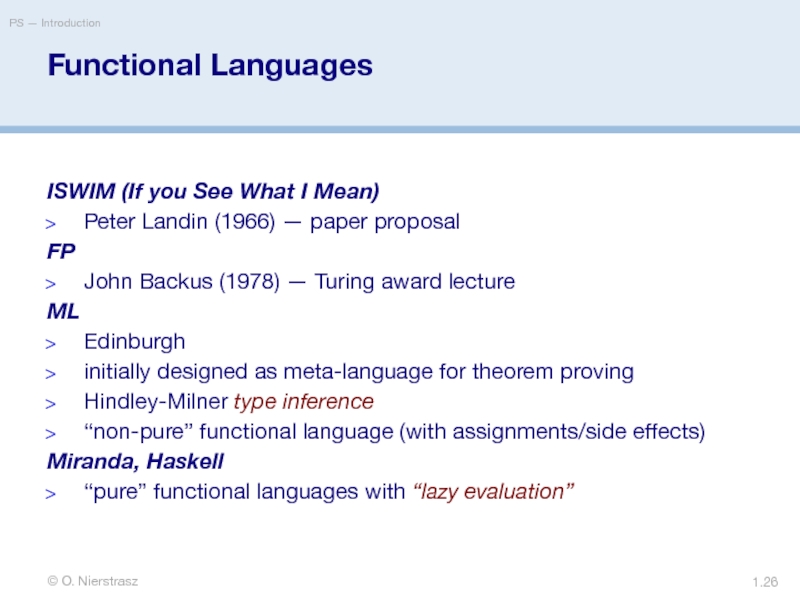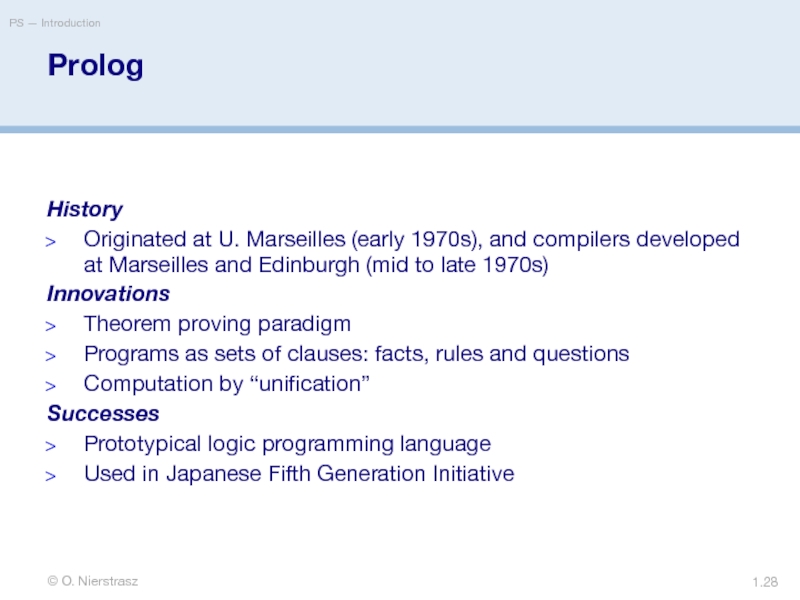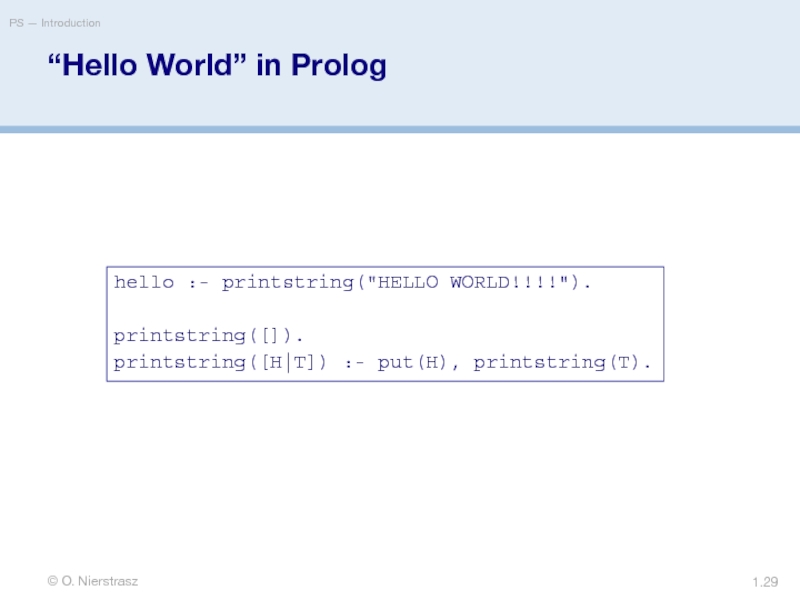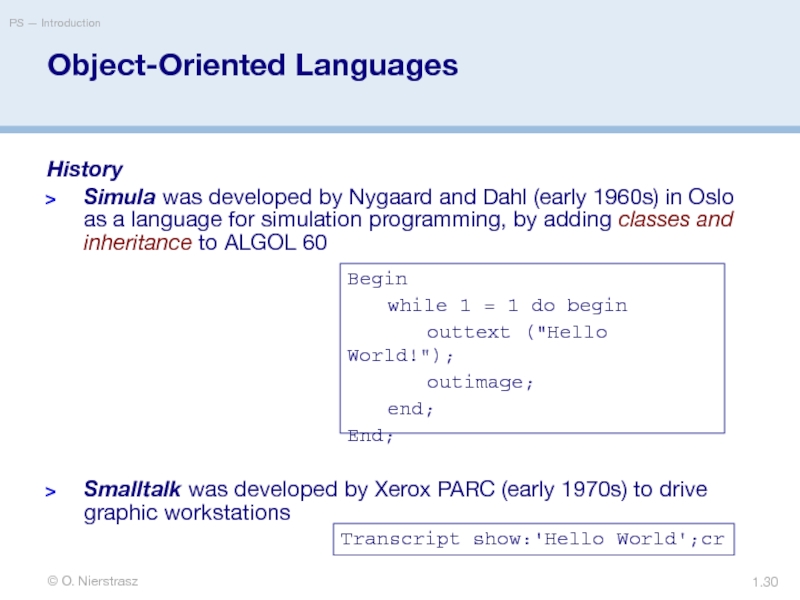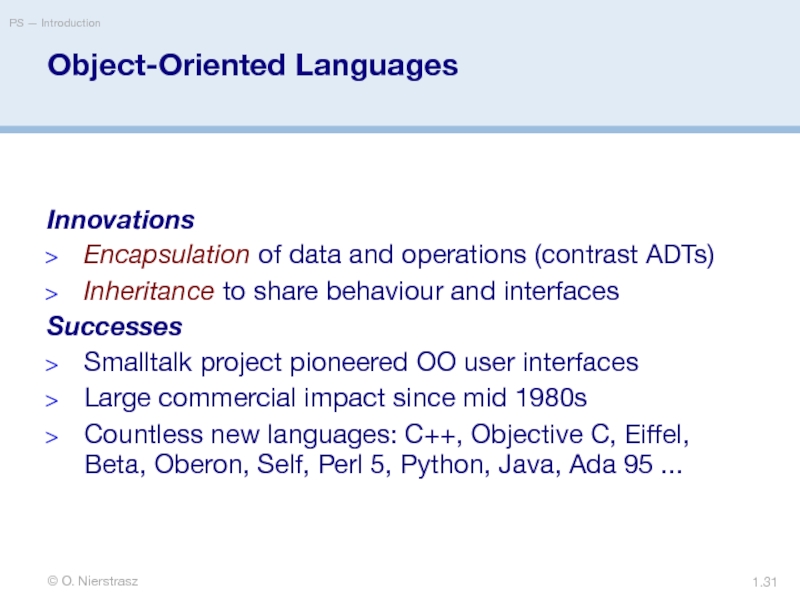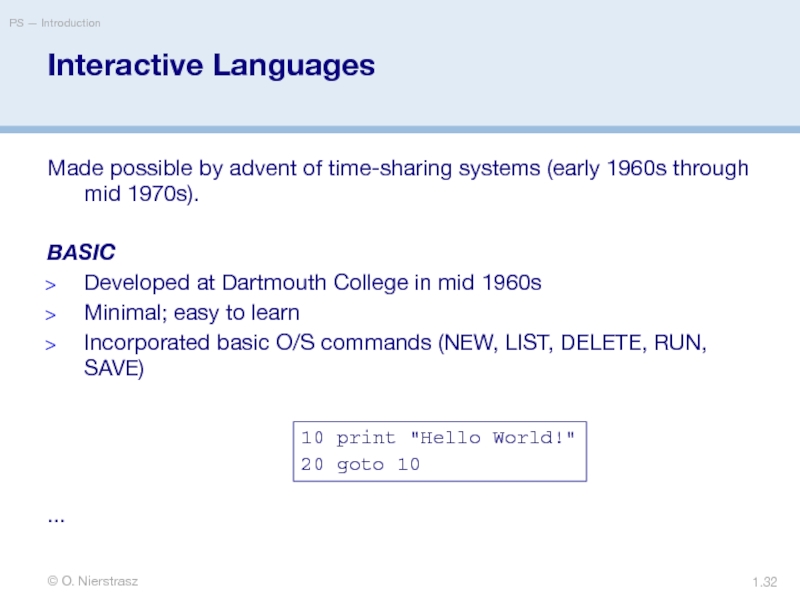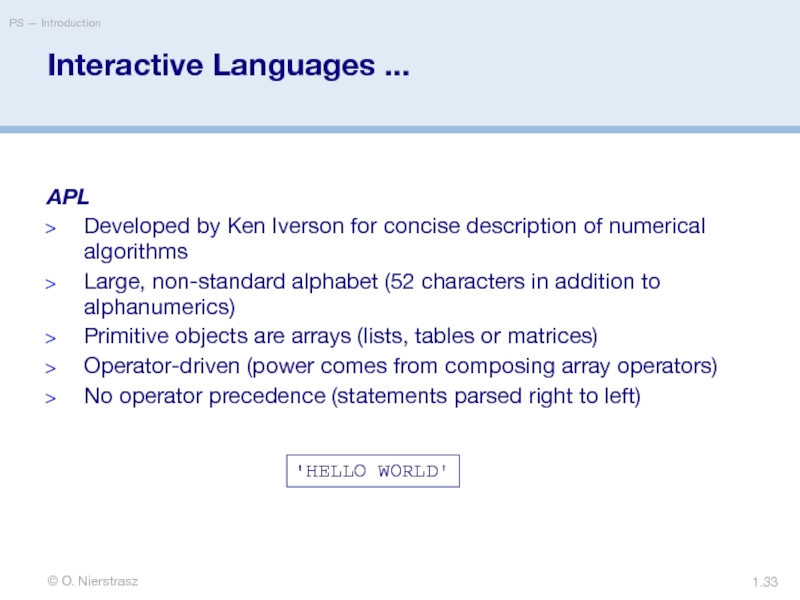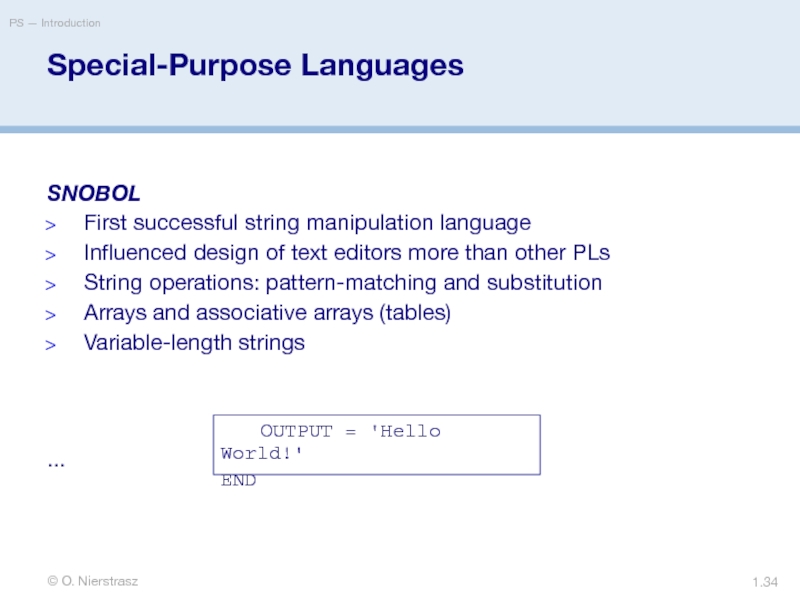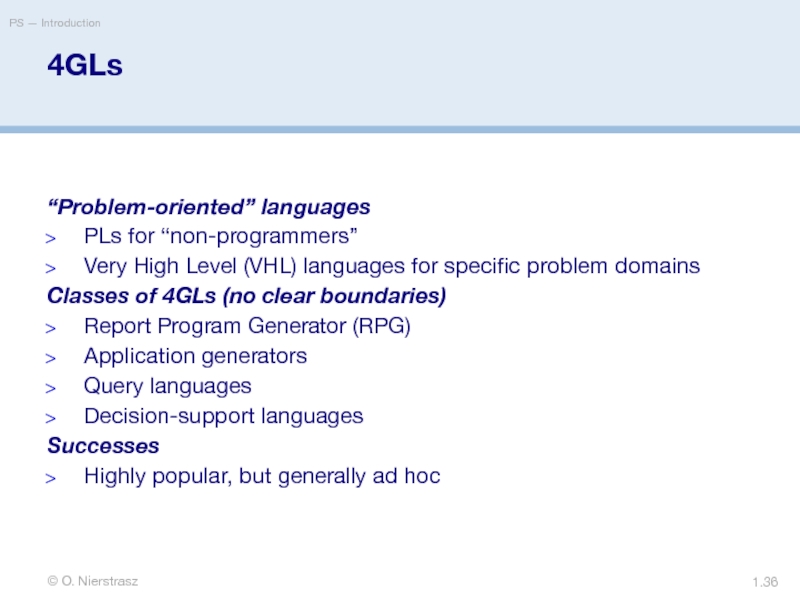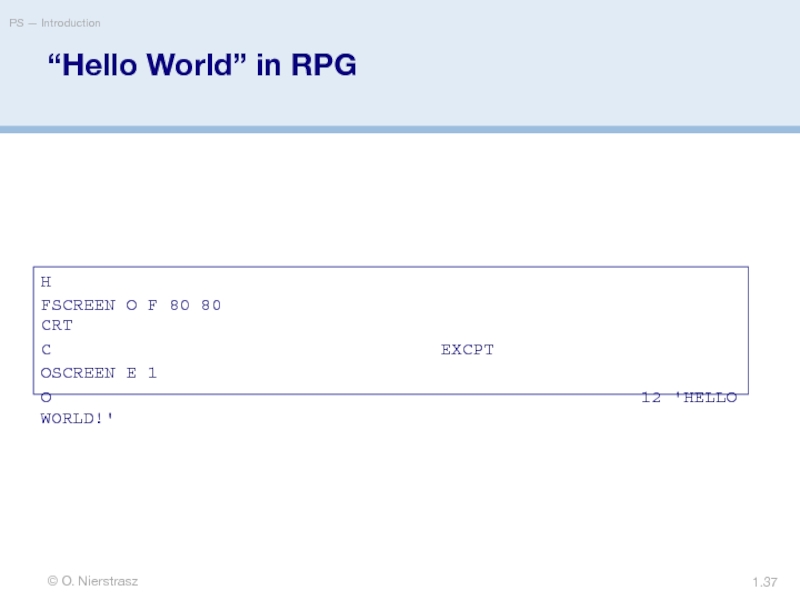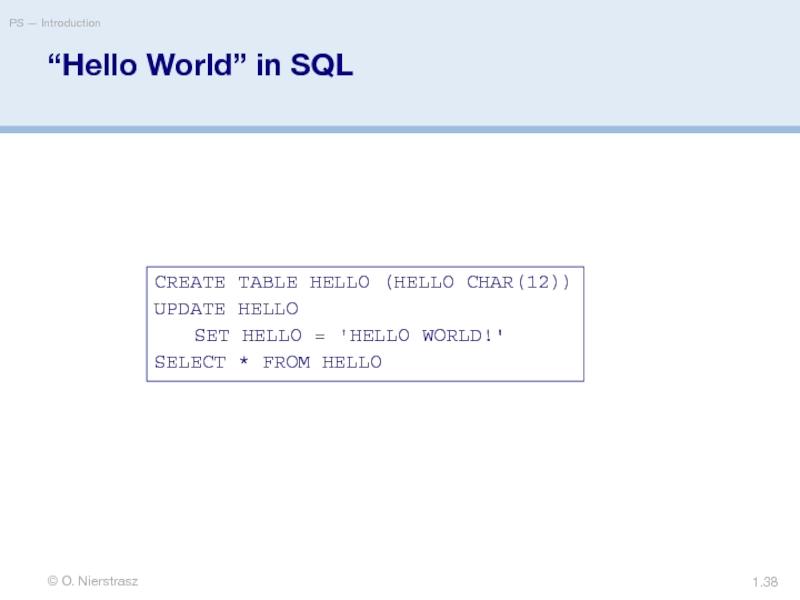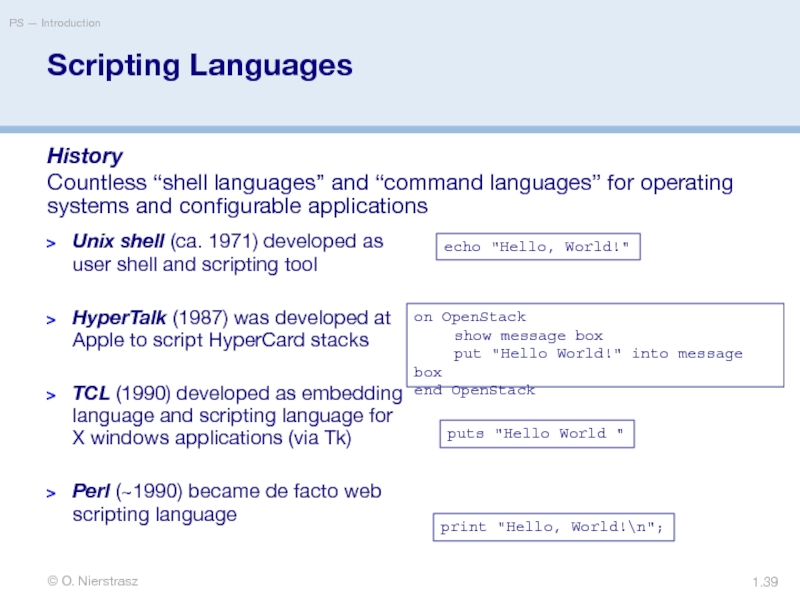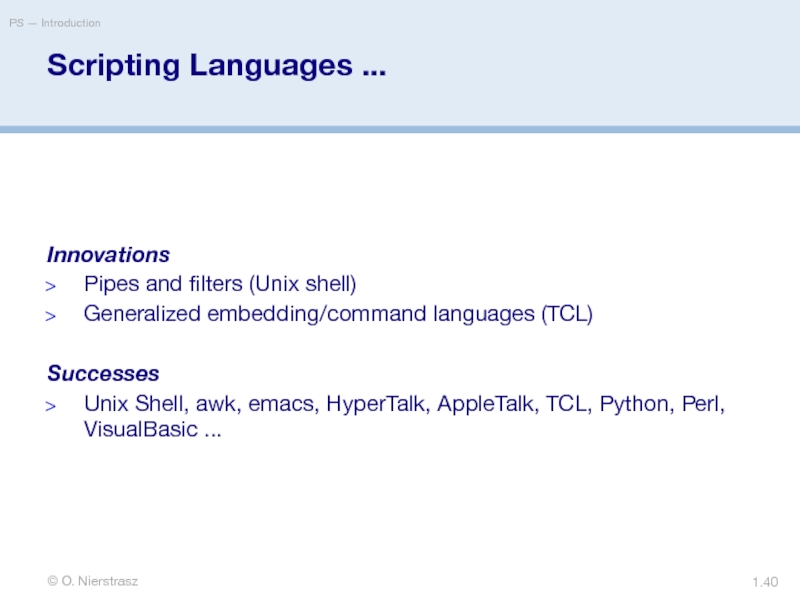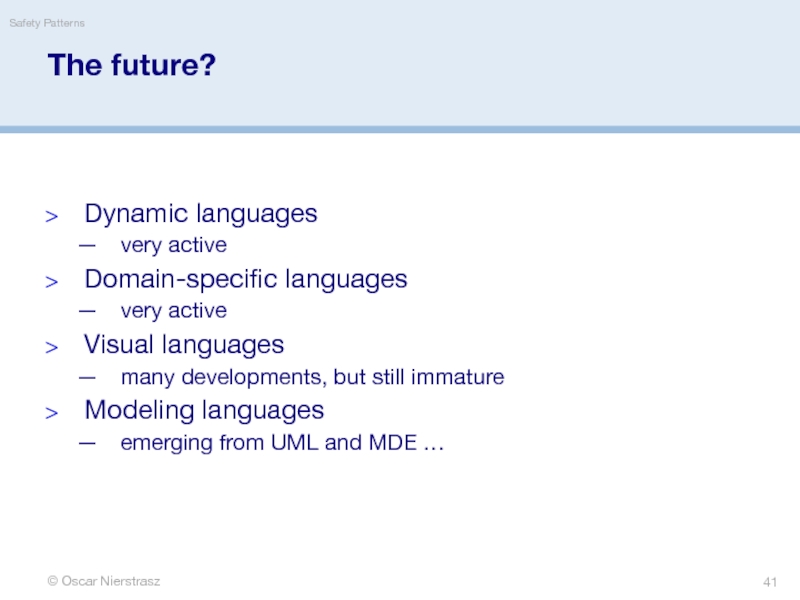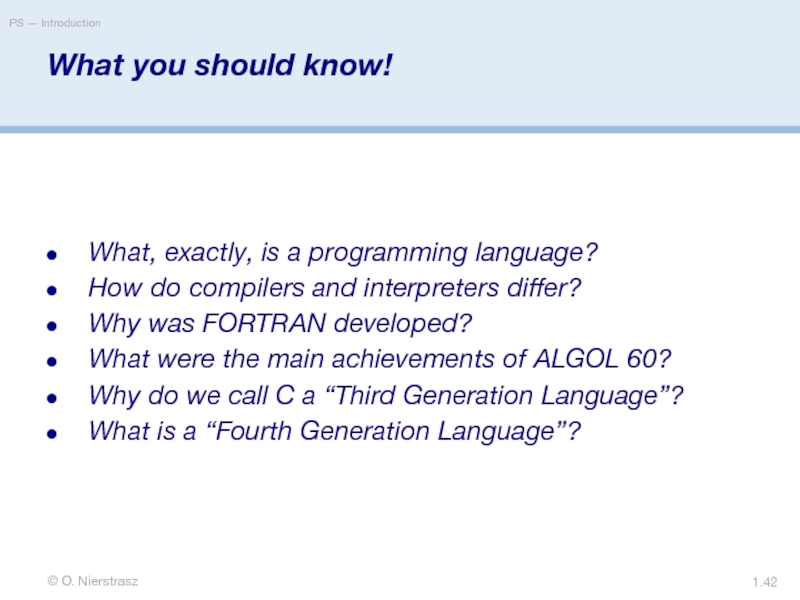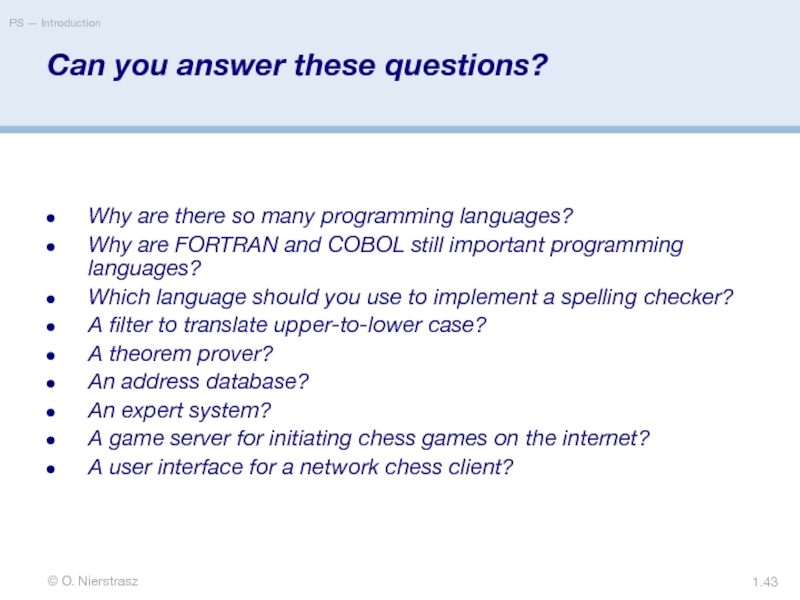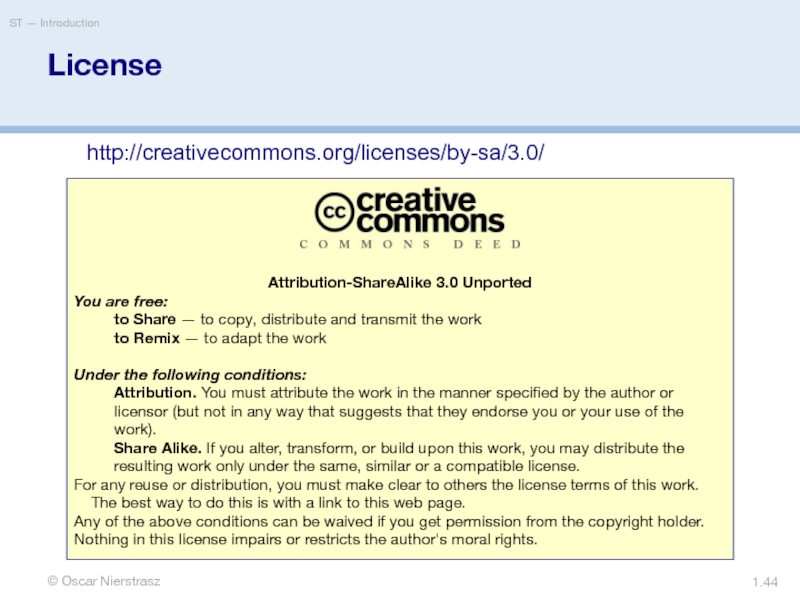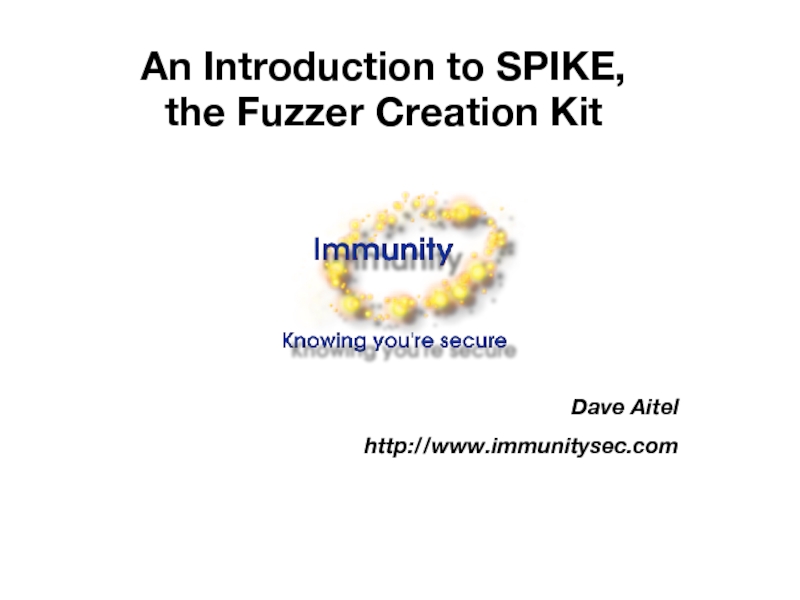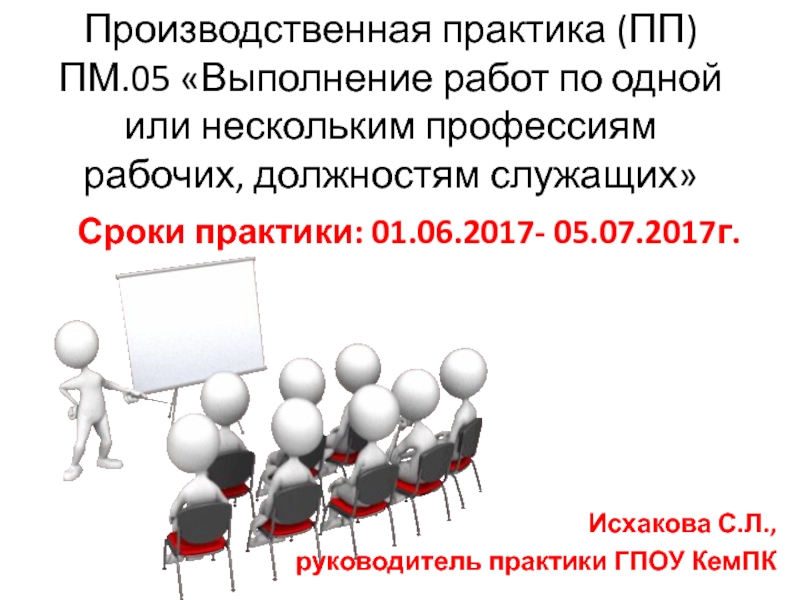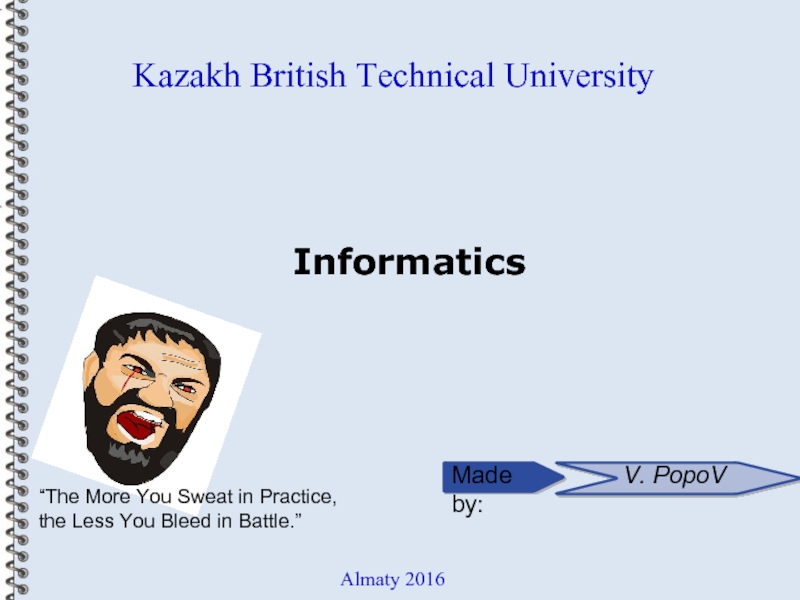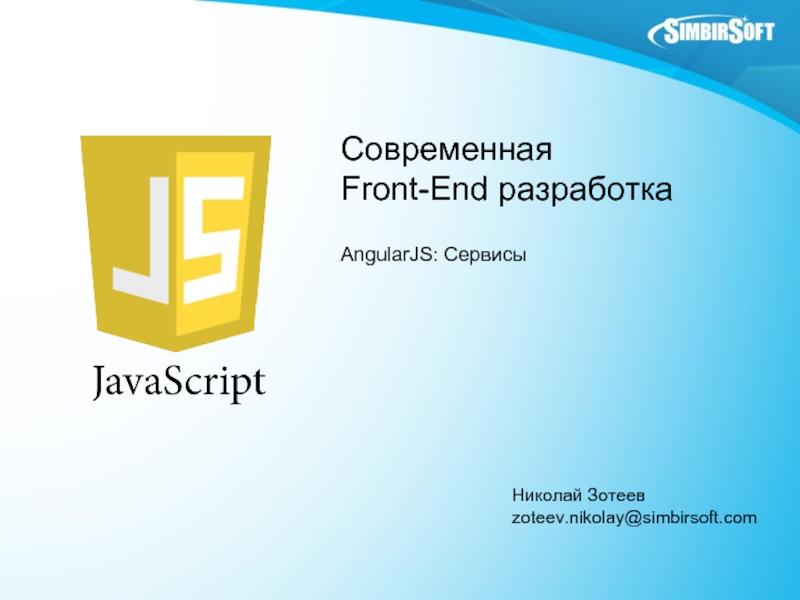- Главная
- Разное
- Дизайн
- Бизнес и предпринимательство
- Аналитика
- Образование
- Развлечения
- Красота и здоровье
- Финансы
- Государство
- Путешествия
- Спорт
- Недвижимость
- Армия
- Графика
- Культурология
- Еда и кулинария
- Лингвистика
- Английский язык
- Астрономия
- Алгебра
- Биология
- География
- Детские презентации
- Информатика
- История
- Литература
- Маркетинг
- Математика
- Медицина
- Менеджмент
- Музыка
- МХК
- Немецкий язык
- ОБЖ
- Обществознание
- Окружающий мир
- Педагогика
- Русский язык
- Технология
- Физика
- Философия
- Химия
- Шаблоны, картинки для презентаций
- Экология
- Экономика
- Юриспруденция
Programming languages презентация
Содержание
- 1. Programming languages
- 2. © O. Nierstrasz PS — Introduction 1. Programming Languages
- 3. © O. Nierstrasz PS — Introduction 1. Roadmap
- 4. © O. Nierstrasz PS — Introduction 1. Roadmap
- 5. © O. Nierstrasz PS — Introduction 1. Sources
- 6. © O. Nierstrasz PS — Introduction 1. Schedule
- 7. © O. Nierstrasz PS — Introduction 1. Roadmap
- 8. What is a Programming Language? © O.
- 9. What is a Programming Language? (II) ©
- 10. Themes Addressed in this Course © O.
- 11. © O. Nierstrasz PS — Introduction 1. Generations
- 12. © O. Nierstrasz PS — Introduction 1. How
- 13. © O. Nierstrasz PS — Introduction 1. Programming Paradigms
- 14. © O. Nierstrasz PS — Introduction 1. Compilers
- 15. © O. Nierstrasz PS — Introduction 1. Roadmap
- 16. © O. Nierstrasz PS — Introduction 1. A Brief Chronology
- 17. © O. Nierstrasz PS — Introduction 1. Fortran
- 18. © O. Nierstrasz PS — Introduction 1. Fortran
- 19. © O. Nierstrasz PS — Introduction 1. “Hello
- 20. © O. Nierstrasz PS — Introduction 1. ALGOL
- 21. © O. Nierstrasz PS — Introduction 1. “Hello
- 22. © O. Nierstrasz PS — Introduction 1. COBOL
- 23. © O. Nierstrasz PS — Introduction 1. “Hello
- 24. © O. Nierstrasz PS — Introduction 1. PL/1
- 25. © O. Nierstrasz PS — Introduction 1. “Hello
- 26. © O. Nierstrasz PS — Introduction 1. Functional
- 27. © O. Nierstrasz PS — Introduction 1. “Hello
- 28. © O. Nierstrasz PS — Introduction 1. Prolog
- 29. © O. Nierstrasz PS — Introduction 1. “Hello
- 30. © O. Nierstrasz PS — Introduction 1. Object-Oriented
- 31. © O. Nierstrasz PS — Introduction 1. Object-Oriented
- 32. © O. Nierstrasz PS — Introduction 1. Interactive
- 33. © O. Nierstrasz PS — Introduction 1. Interactive
- 34. © O. Nierstrasz PS — Introduction 1. Special-Purpose
- 35. © O. Nierstrasz PS — Introduction 1. Symbolic
- 36. © O. Nierstrasz PS — Introduction 1. 4GLs
- 37. © O. Nierstrasz PS — Introduction 1. “Hello
- 38. © O. Nierstrasz PS — Introduction 1. “Hello
- 39. © O. Nierstrasz PS — Introduction 1. Scripting
- 40. © O. Nierstrasz PS — Introduction 1. Scripting
- 41. The future? Dynamic languages very active Domain-specific
- 42. © O. Nierstrasz PS — Introduction 1. What
- 43. © O. Nierstrasz PS — Introduction 1. Can
- 44. © Oscar Nierstrasz ST — Introduction 1.
Слайд 3© O. Nierstrasz
PS — Introduction
1.
Roadmap
Course Schedule
Programming Paradigms
A Quick Tour of Programming Language
Слайд 4© O. Nierstrasz
PS — Introduction
1.
Roadmap
Course Schedule
Programming Paradigms
A Quick Tour of Programming Language
Слайд 5© O. Nierstrasz
PS — Introduction
1.
Sources
Text:
Kenneth C. Louden, Programming Languages: Principles and Practice,
Other Sources:
Paul Hudak, “Conception, Evolution, and Application of Functional Programming Languages,” ACM Computing Surveys 21/3, 1989, pp 359-411.
Clocksin and Mellish, Programming in Prolog, Springer Verlag, 1987.
Слайд 6© O. Nierstrasz
PS — Introduction
1.
Schedule
Introduction
Stack-based programming
Scheme (guest lecture)
Functional programming
Types and polymorphism
Lambda calculus
Fixed
Programming language semantics
Objects and types
Logic programming
Applications of logic programming
Visual programming
Final exam
Слайд 7© O. Nierstrasz
PS — Introduction
1.
Roadmap
Course Schedule
Programming Paradigms
A Quick Tour of Programming Language
Слайд 8What is a Programming Language?
© O. Nierstrasz
PS — Introduction
1.
A formal language for
A “user interface” to a computer?
Syntax + semantics?
Compiler, or interpreter, or translator?
A tool to support a programming paradigm?
A programming language is a notational system for describing computation in a machine-readable and human-readable form.
— Louden
Слайд 9What is a Programming Language? (II)
© O. Nierstrasz
PS — Introduction
1.
A programming language
The thesis of this course:
Слайд 10Themes Addressed in this Course
© O. Nierstrasz
PS — Introduction
1.
Paradigms
How do different language
Semantics
How can we understand the semantics of programming languages?
Foundations
What are the foundations of programming languages?
Слайд 11© O. Nierstrasz
PS — Introduction
1.
Generations of Programming Languages
1GL: machine codes
2GL: symbolic assemblers
3GL:
4GL: domain specific application generators
5GL: AI languages …
Each generation is at a higher level of abstraction
Слайд 12© O. Nierstrasz
PS — Introduction
1.
How do Programming Languages Differ?
Common Constructs:
basic data types
Uncommon Constructs:
type declarations; special types (strings, arrays, matrices, ...); sequential execution; concurrency constructs; packages/modules; objects; general functions; generics; modifiable state; ...
Слайд 14© O. Nierstrasz
PS — Introduction
1.
Compilers and Interpreters
Compilers and interpreters have similar front-ends,
Слайд 15© O. Nierstrasz
PS — Introduction
1.
Roadmap
Course Schedule
Programming Paradigms
A Quick Tour of Programming Language
Слайд 17© O. Nierstrasz
PS — Introduction
1.
Fortran
History
John Backus (1953) sought to write programs in
No language design effort (made it up as they went along)
Most effort spent on code generation and optimization
FORTRAN I released April 1957; working by April 1958
The current standard is FORTRAN 2003 (FORTRAN 2008 is work in progress)
Слайд 18© O. Nierstrasz
PS — Introduction
1.
Fortran …
Innovations
Symbolic notation for subroutines and functions
Assignments to
DO loops
Comments
Input/output formats
Machine-independence
Successes
Easy to learn; high level
Promoted by IBM; addressed large user base
(scientific computing)
Слайд 19© O. Nierstrasz
PS — Introduction
1.
“Hello World” in FORTRAN
All examples from the ACM
www2.latech.edu/~acm/HelloWorld.shtml
PROGRAM HELLO
DO 10, I=1,10
PRINT *,'Hello World'
10 CONTINUE
STOP
END
Слайд 20© O. Nierstrasz
PS — Introduction
1.
ALGOL 60
History
Committee of PL experts formed in 1955
First version (ALGOL 58) never implemented; criticisms led to ALGOL 60
Innovations
BNF (Backus-Naur Form) introduced to define syntax (led to syntax-directed compilers)
First block-structured language; variables with local scope
Structured control statements
Recursive procedures
Variable size arrays
Successes
Highly influenced design of other PLs but never displaced FORTRAN
Слайд 21© O. Nierstrasz
PS — Introduction
1.
“Hello World” in BEALGOL
BEGIN
FILE F (KIND=REMOTE);
EBCDIC ARRAY E
REPLACE E BY "HELLO WORLD!";
WHILE TRUE DO
BEGIN
WRITE (F, *, E);
END;
END.
Слайд 22© O. Nierstrasz
PS — Introduction
1.
COBOL
History
Designed by committee of US computer manufacturers
Targeted business
Intended to be readable by managers (!)
Innovations
Separate descriptions of environment, data, and processes
Successes
Adopted as de facto standard by US DOD
Stable standard for 25 years
Still the most widely used PL for business applications (!)
Слайд 23© O. Nierstrasz
PS — Introduction
1.
“Hello World” in COBOL
000100 IDENTIFICATION DIVISION.
000200 PROGRAM-ID.
000300 DATE-WRITTEN. 02/05/96 21:04.
000400* AUTHOR BRIAN COLLINS
000500 ENVIRONMENT DIVISION.
000600 CONFIGURATION SECTION.
000700 SOURCE-COMPUTER. RM-COBOL.
000800 OBJECT-COMPUTER. RM-COBOL.
001000 DATA DIVISION.
001100 FILE SECTION.
100000 PROCEDURE DIVISION.
100200 MAIN-LOGIC SECTION.
100300 BEGIN.
100400 DISPLAY " " LINE 1 POSITION 1 ERASE EOS.
100500 DISPLAY "HELLO, WORLD." LINE 15 POSITION 10.
100600 STOP RUN.
100700 MAIN-LOGIC-EXIT.
100800 EXIT.
Слайд 24© O. Nierstrasz
PS — Introduction
1.
PL/1
History
Designed by committee of IBM and users (early
Intended as (large) general-purpose language for broad classes of applications
Innovations
Support for concurrency (but not synchronization)
Exception-handling on conditions
Successes
Achieved both run-time efficiency and flexibility (at expense of complexity)
First “complete” general purpose language
Слайд 25© O. Nierstrasz
PS — Introduction
1.
“Hello World” in PL/1
HELLO: PROCEDURE OPTIONS (MAIN);
/*
FLAG = 0;
LOOP: DO WHILE (FLAG = 0);
PUT SKIP DATA('HELLO WORLD!');
END LOOP;
END HELLO;
Слайд 26© O. Nierstrasz
PS — Introduction
1.
Functional Languages
ISWIM (If you See What I Mean)
Peter
FP
John Backus (1978) — Turing award lecture
ML
Edinburgh
initially designed as meta-language for theorem proving
Hindley-Milner type inference
“non-pure” functional language (with assignments/side effects)
Miranda, Haskell
“pure” functional languages with “lazy evaluation”
Слайд 27© O. Nierstrasz
PS — Introduction
1.
“Hello World” in Functional Languages
SML
Haskell
print("hello world!\n");
hello() = print
Слайд 28© O. Nierstrasz
PS — Introduction
1.
Prolog
History
Originated at U. Marseilles (early 1970s), and compilers
Innovations
Theorem proving paradigm
Programs as sets of clauses: facts, rules and questions
Computation by “unification”
Successes
Prototypical logic programming language
Used in Japanese Fifth Generation Initiative
Слайд 29© O. Nierstrasz
PS — Introduction
1.
“Hello World” in Prolog
hello :- printstring("HELLO WORLD!!!!").
printstring([]).
printstring([H|T]) :-
Слайд 30© O. Nierstrasz
PS — Introduction
1.
Object-Oriented Languages
History
Simula was developed by Nygaard and Dahl
Smalltalk was developed by Xerox PARC (early 1970s) to drive graphic workstations
Begin
while 1 = 1 do begin
outtext ("Hello World!");
outimage;
end;
End;
Transcript show:'Hello World';cr
Слайд 31© O. Nierstrasz
PS — Introduction
1.
Object-Oriented Languages
Innovations
Encapsulation of data and operations (contrast ADTs)
Inheritance
Successes
Smalltalk project pioneered OO user interfaces
Large commercial impact since mid 1980s
Countless new languages: C++, Objective C, Eiffel, Beta, Oberon, Self, Perl 5, Python, Java, Ada 95 ...
Слайд 32© O. Nierstrasz
PS — Introduction
1.
Interactive Languages
Made possible by advent of time-sharing systems
BASIC
Developed at Dartmouth College in mid 1960s
Minimal; easy to learn
Incorporated basic O/S commands (NEW, LIST, DELETE, RUN, SAVE)
...
10 print "Hello World!"
20 goto 10
Слайд 33© O. Nierstrasz
PS — Introduction
1.
Interactive Languages ...
APL
Developed by Ken Iverson for concise
Large, non-standard alphabet (52 characters in addition to alphanumerics)
Primitive objects are arrays (lists, tables or matrices)
Operator-driven (power comes from composing array operators)
No operator precedence (statements parsed right to left)
'HELLO WORLD'
Слайд 34© O. Nierstrasz
PS — Introduction
1.
Special-Purpose Languages
SNOBOL
First successful string manipulation language
Influenced design of
String operations: pattern-matching and substitution
Arrays and associative arrays (tables)
Variable-length strings
...
OUTPUT = 'Hello World!'
END
Слайд 35© O. Nierstrasz
PS — Introduction
1.
Symbolic Languages ...
Lisp
Performs computations on symbolic expressions
Symbolic expressions
Small set of constructor/selector operations to create and manipulate lists
Recursive rather than iterative control
No distinction between data and programs
First PL to implement storage management by garbage collection
Affinity with lambda calculus
(DEFUN HELLO-WORLD ()
(PRINT (LIST 'HELLO 'WORLD)))
Слайд 36© O. Nierstrasz
PS — Introduction
1.
4GLs
“Problem-oriented” languages
PLs for “non-programmers”
Very High Level (VHL) languages
Classes of 4GLs (no clear boundaries)
Report Program Generator (RPG)
Application generators
Query languages
Decision-support languages
Successes
Highly popular, but generally ad hoc
Слайд 37© O. Nierstrasz
PS — Introduction
1.
“Hello World” in RPG
H
FSCREEN O F 80 80
C EXCPT
OSCREEN E 1
O 12 'HELLO WORLD!'
Слайд 38© O. Nierstrasz
PS — Introduction
1.
“Hello World” in SQL
CREATE TABLE HELLO (HELLO CHAR(12))
UPDATE
SET HELLO = 'HELLO WORLD!'
SELECT * FROM HELLO
Слайд 39© O. Nierstrasz
PS — Introduction
1.
Scripting Languages
History
Countless “shell languages” and “command languages” for
echo "Hello, World!"
on OpenStack
show message box
put "Hello World!" into message box
end OpenStack
puts "Hello World "
print "Hello, World!\n";
Unix shell (ca. 1971) developed as user shell and scripting tool
HyperTalk (1987) was developed at Apple to script HyperCard stacks
TCL (1990) developed as embedding language and scripting language for X windows applications (via Tk)
Perl (~1990) became de facto web scripting language
Слайд 40© O. Nierstrasz
PS — Introduction
1.
Scripting Languages ...
Innovations
Pipes and filters (Unix shell)
Generalized embedding/command
Successes
Unix Shell, awk, emacs, HyperTalk, AppleTalk, TCL, Python, Perl, VisualBasic ...
Слайд 41The future?
Dynamic languages
very active
Domain-specific languages
very active
Visual languages
many developments, but still immature
Modeling
emerging from UML and MDE …
© Oscar Nierstrasz
Safety Patterns
Слайд 42© O. Nierstrasz
PS — Introduction
1.
What you should know!
What, exactly, is a programming
How do compilers and interpreters differ?
Why was FORTRAN developed?
What were the main achievements of ALGOL 60?
Why do we call C a “Third Generation Language”?
What is a “Fourth Generation Language”?
Слайд 43© O. Nierstrasz
PS — Introduction
1.
Can you answer these questions?
Why are there so
Why are FORTRAN and COBOL still important programming languages?
Which language should you use to implement a spelling checker?
A filter to translate upper-to-lower case?
A theorem prover?
An address database?
An expert system?
A game server for initiating chess games on the internet?
A user interface for a network chess client?
Слайд 44© Oscar Nierstrasz
ST — Introduction
1.
Attribution-ShareAlike 3.0 Unported
You are free:
to Share —
to Remix — to adapt the work
Under the following conditions:
Attribution. You must attribute the work in the manner specified by the author or licensor (but not in any way that suggests that they endorse you or your use of the work).
Share Alike. If you alter, transform, or build upon this work, you may distribute the resulting work only under the same, similar or a compatible license.
For any reuse or distribution, you must make clear to others the license terms of this work. The best way to do this is with a link to this web page.
Any of the above conditions can be waived if you get permission from the copyright holder.
Nothing in this license impairs or restricts the author's moral rights.
License
http://creativecommons.org/licenses/by-sa/3.0/
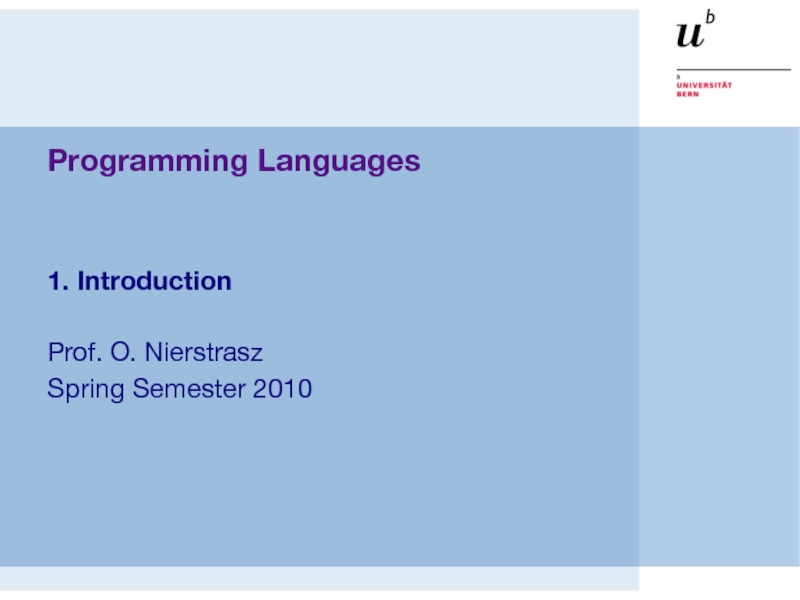
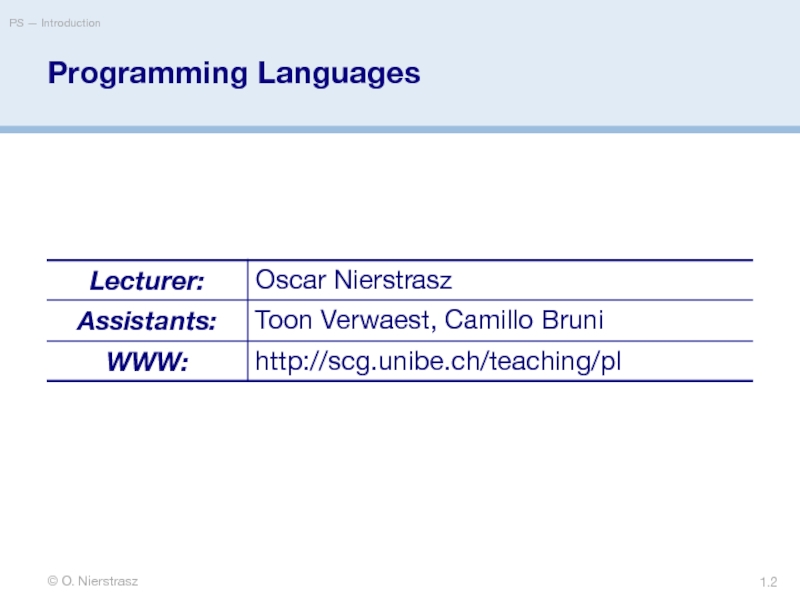
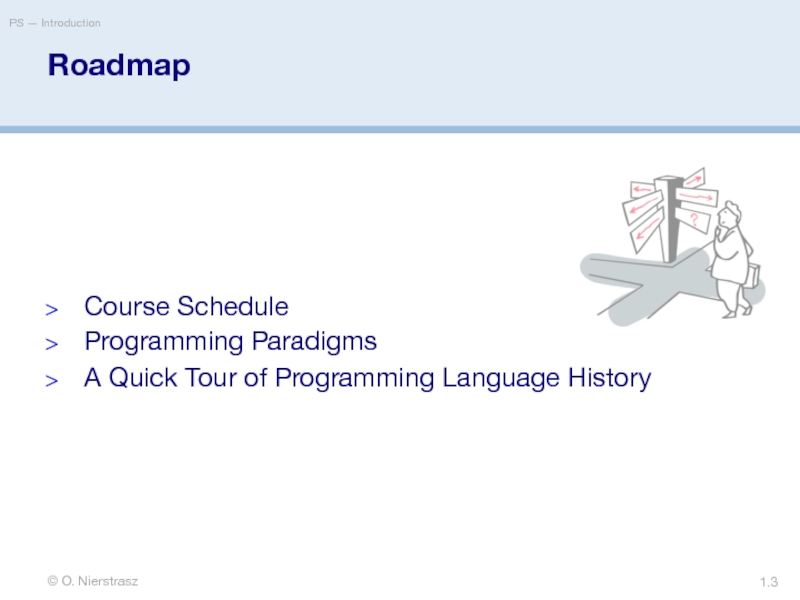
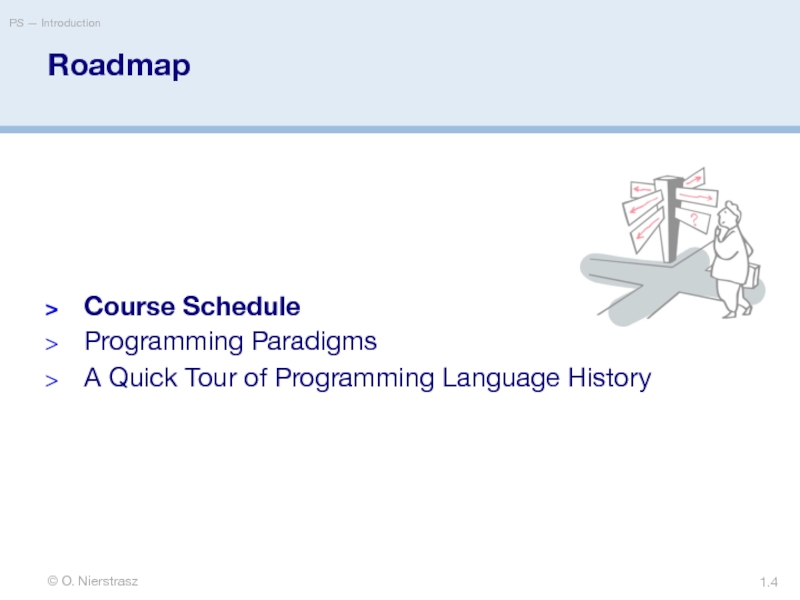
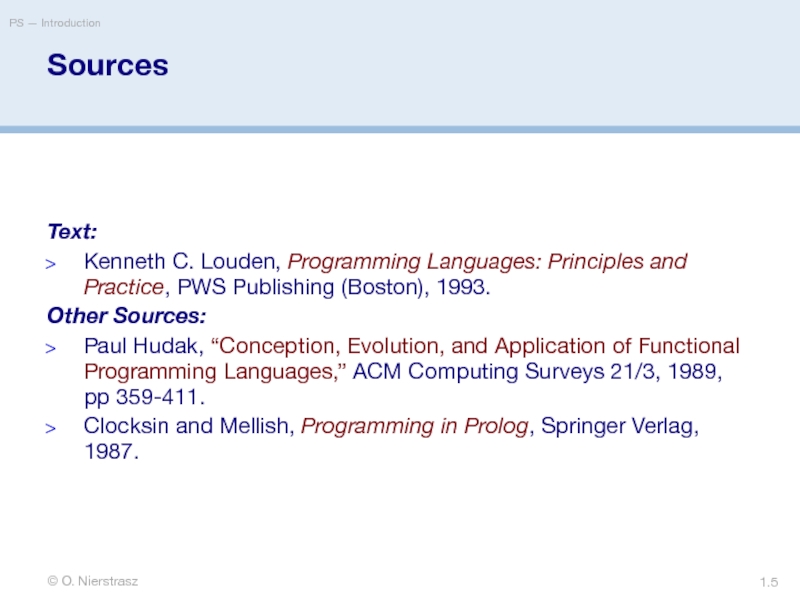
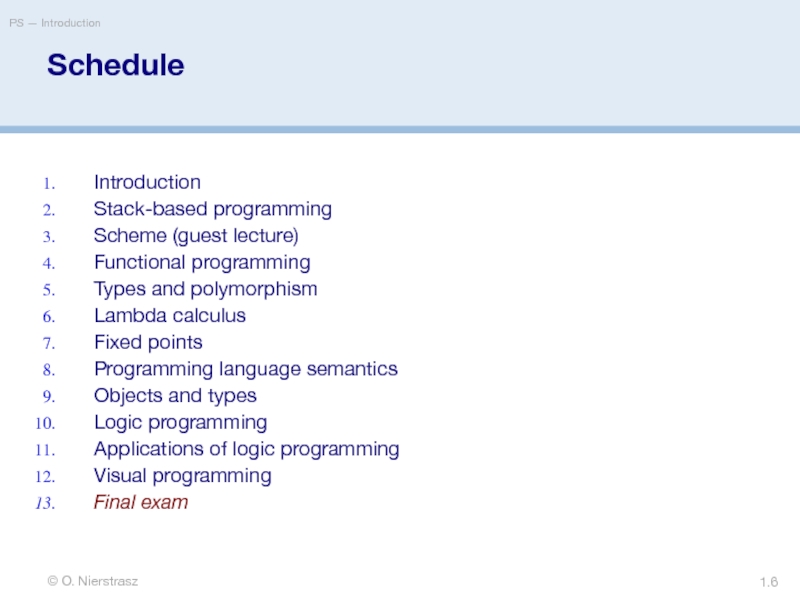
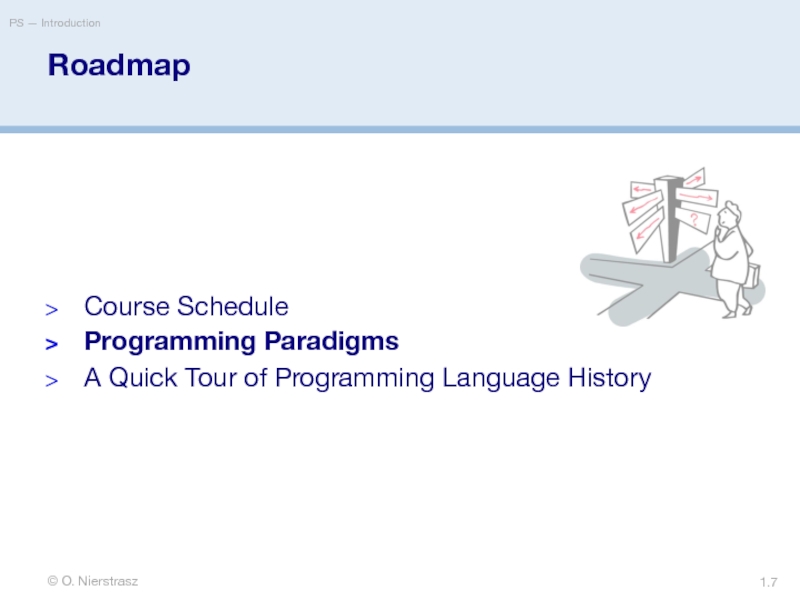
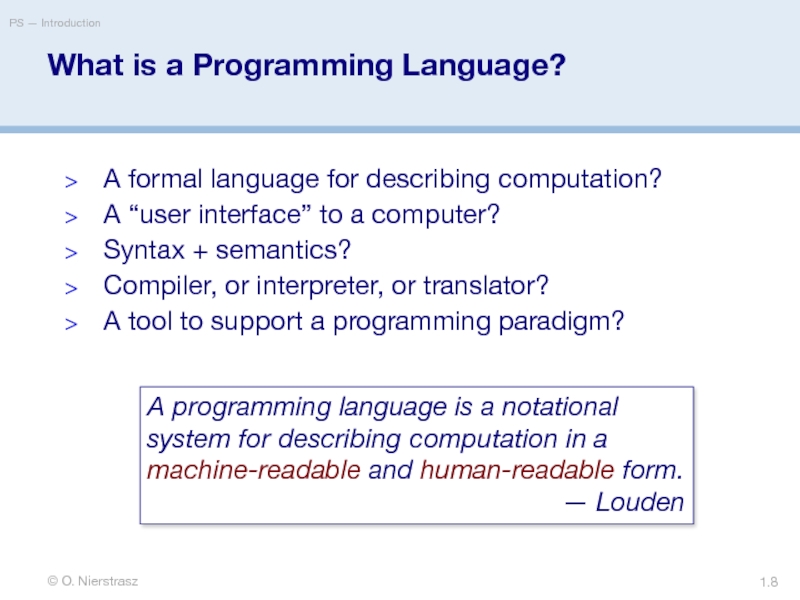
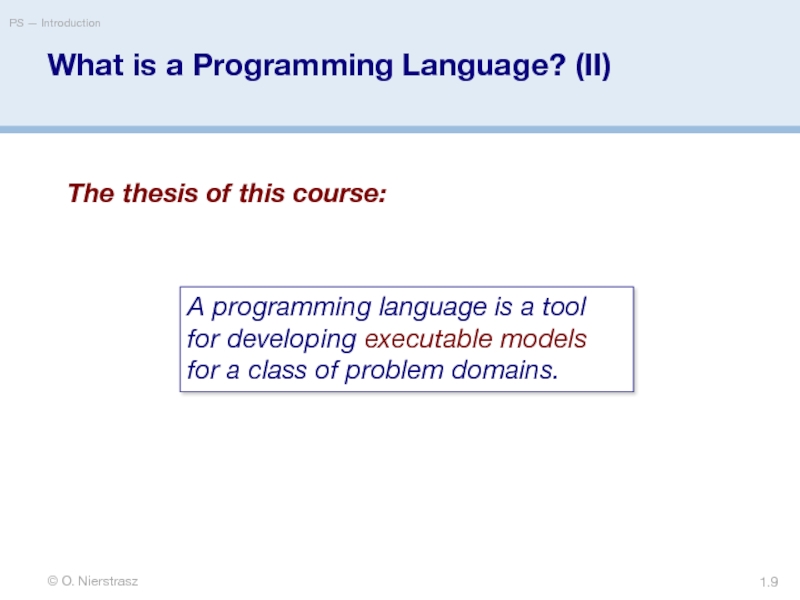
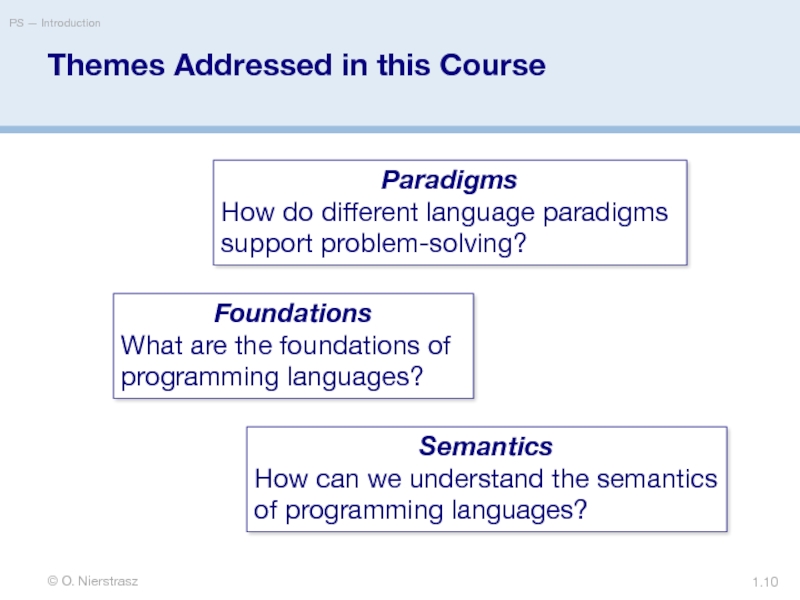
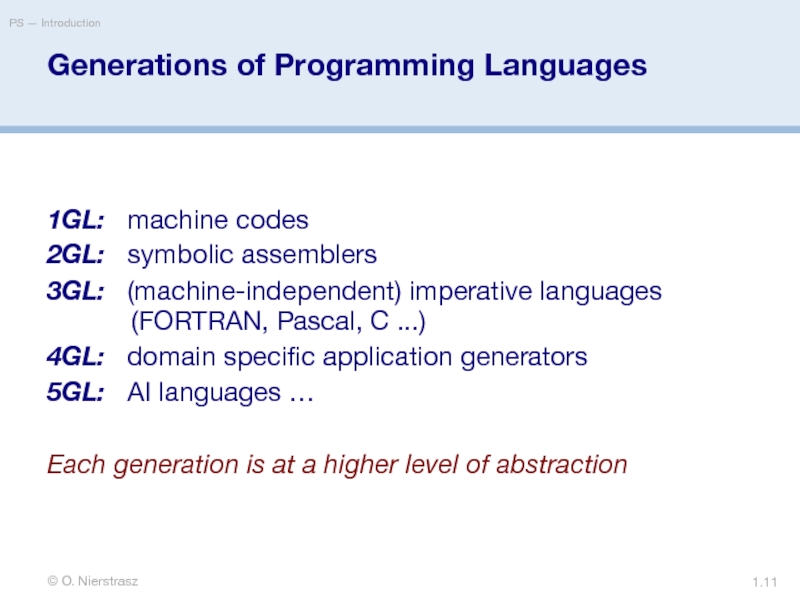
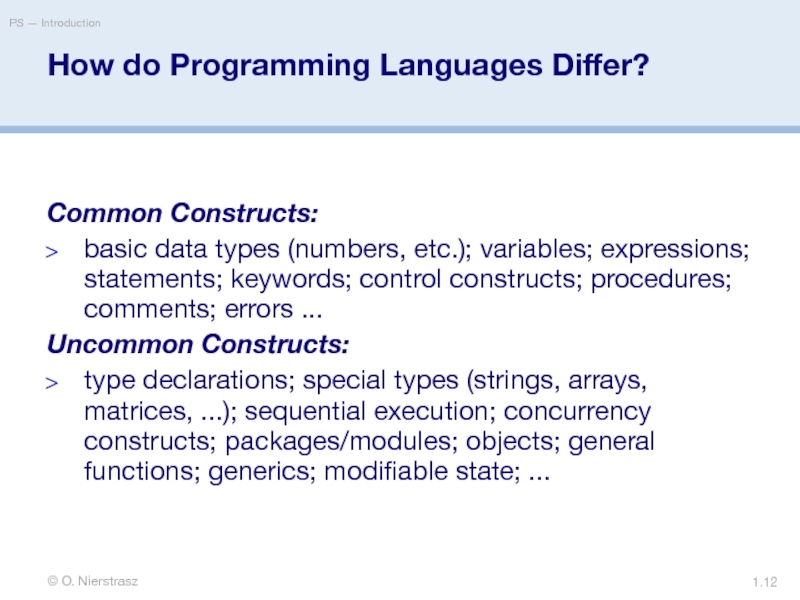
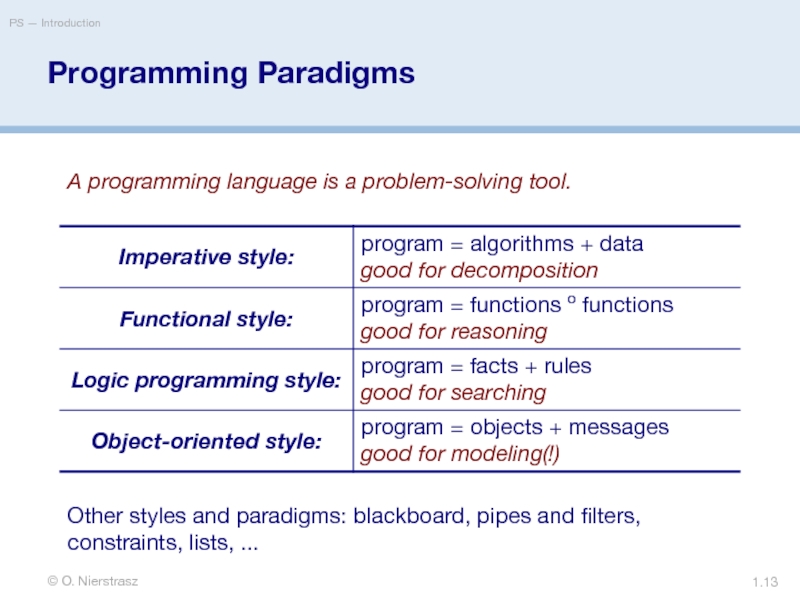
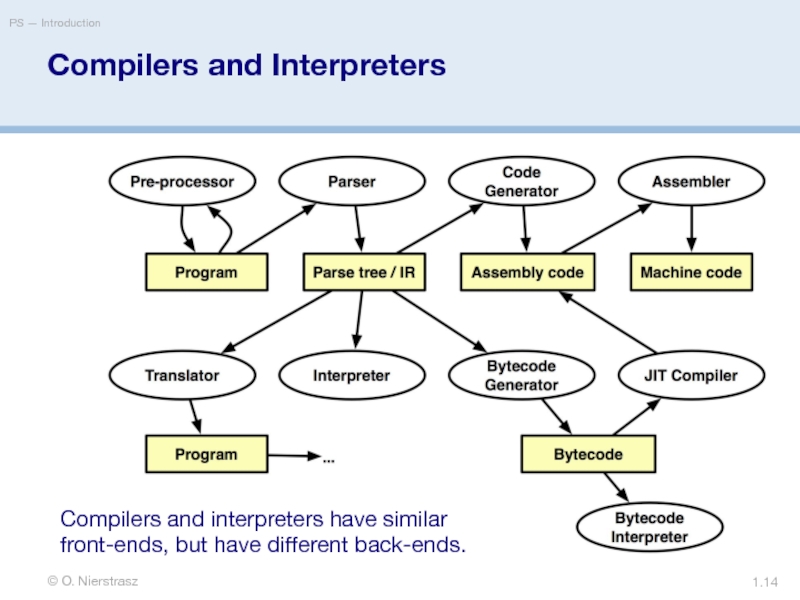
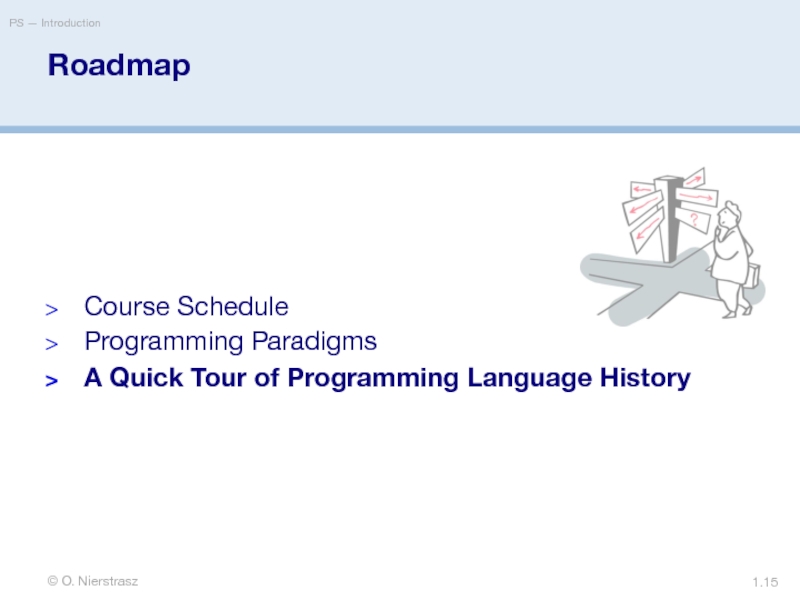
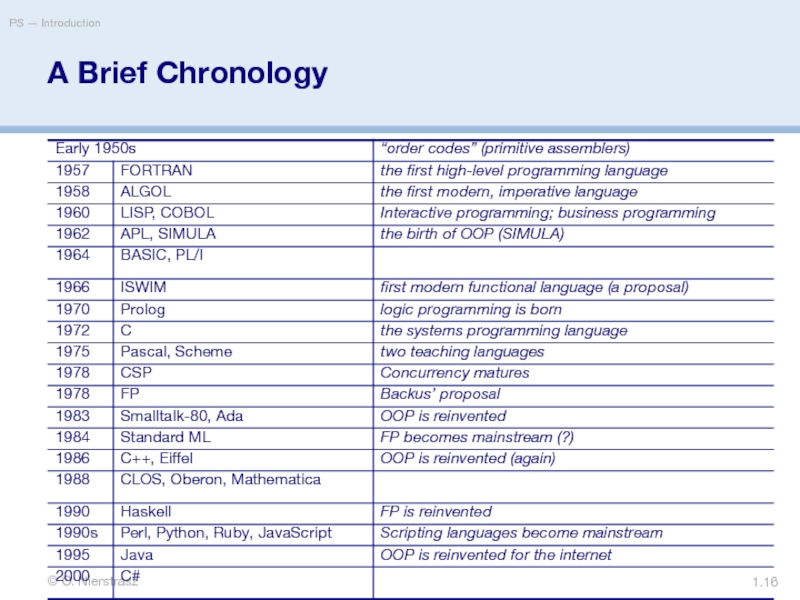
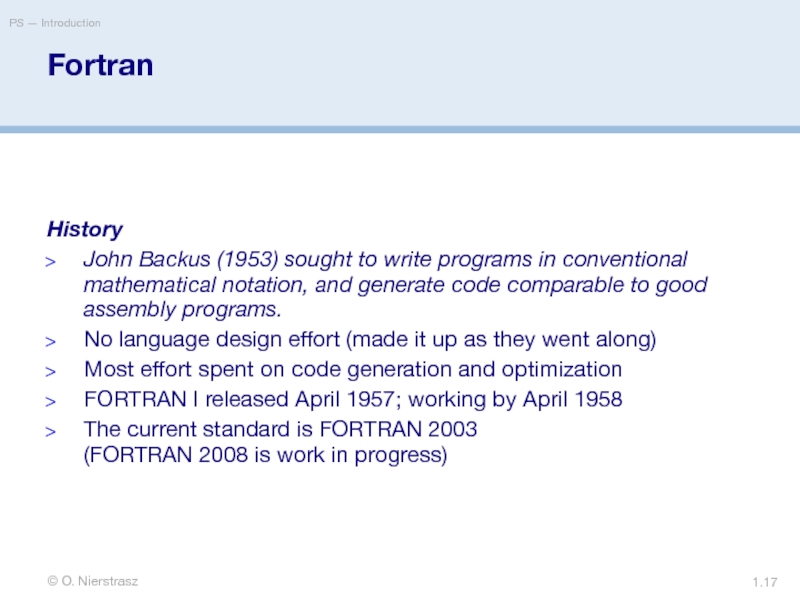
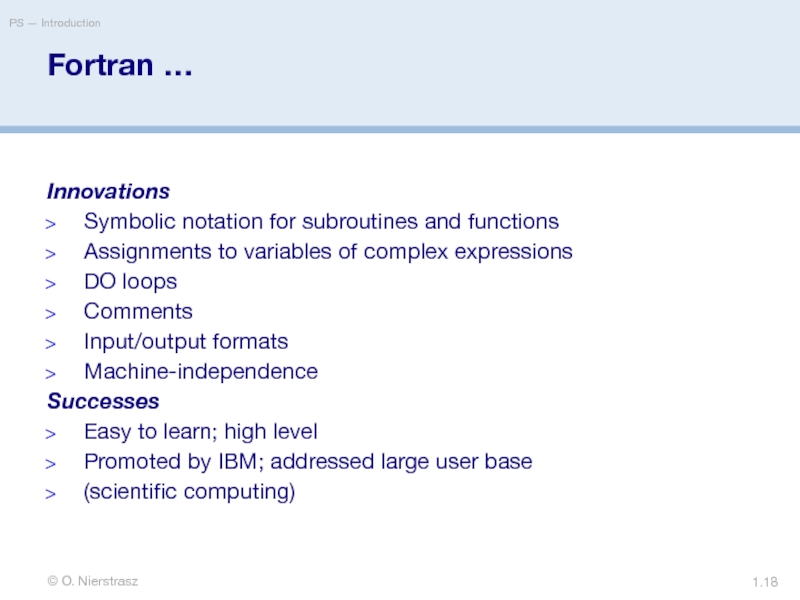
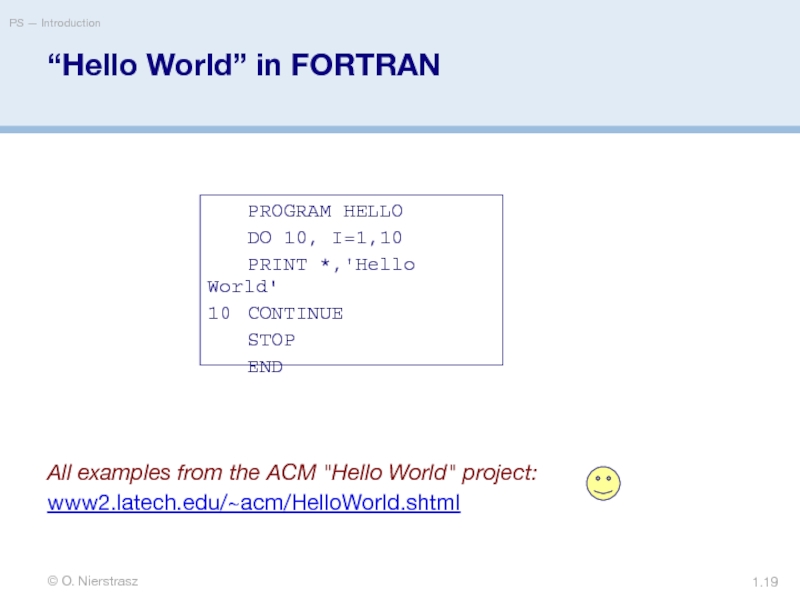
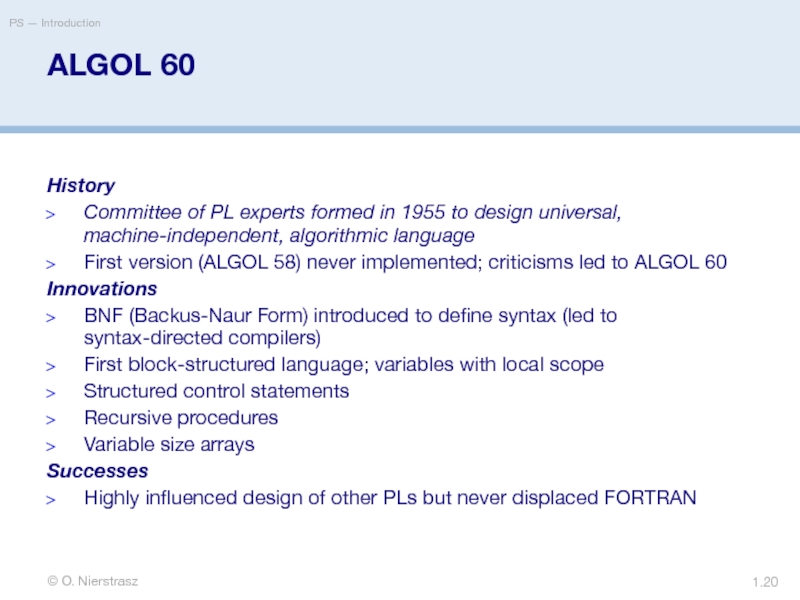
![© O. NierstraszPS — Introduction1.“Hello World” in BEALGOLBEGINFILE F (KIND=REMOTE);EBCDIC ARRAY E [0:11];REPLACE E BY](/img/tmb/4/323669/ae4663bc401e8d62c9c517f5d24eda01-800x.jpg)
